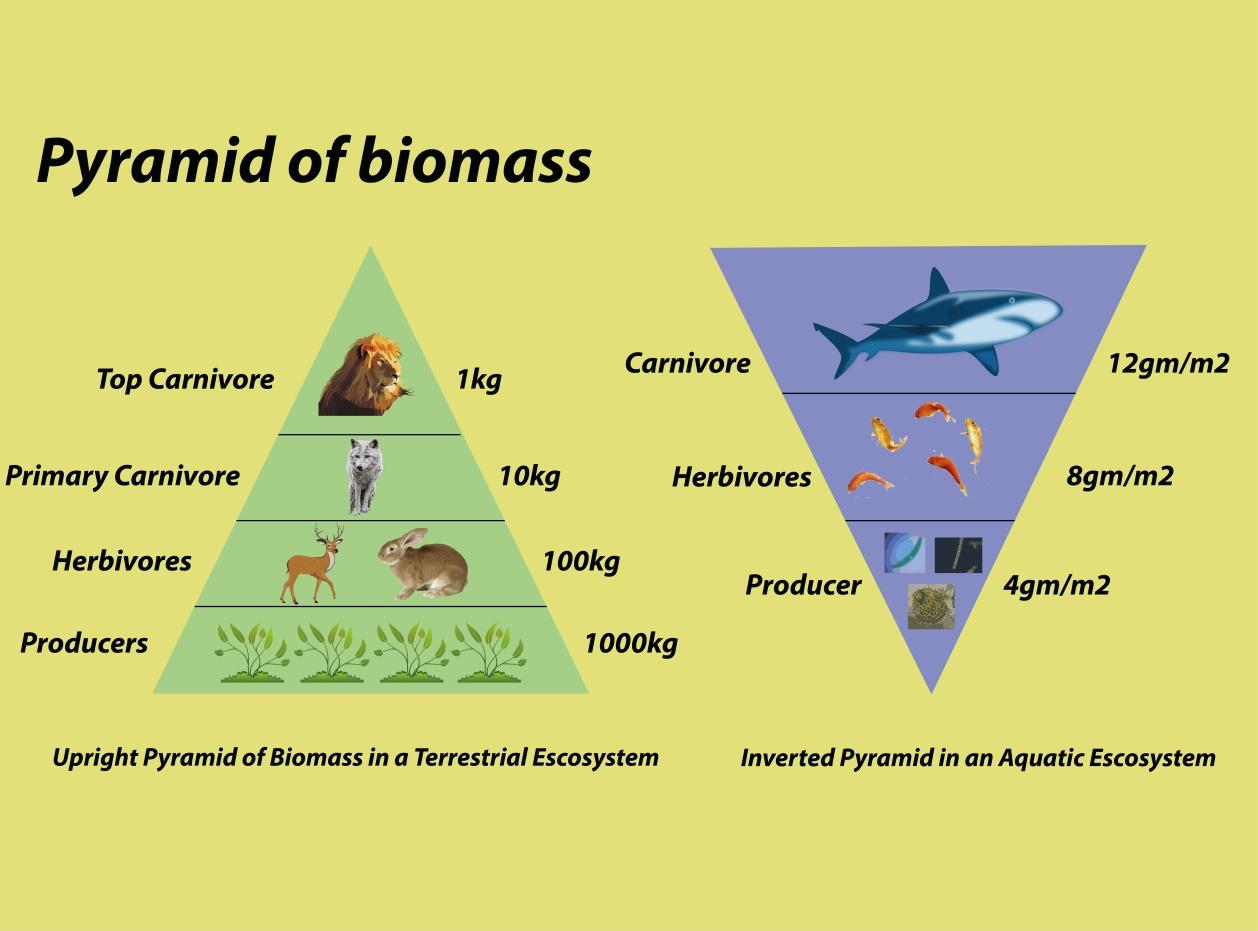
In a food chain, the total amount of living material is depicted by
(a)Pyramid of biomass
(b)Pyramid of energy
(c)Pyramid of numbers
(d)Trophic levels
Answer
453.9k+ views
Hint: This pyramid is a graphical representation of the total amount of weight of the fresh or dry weight of living or organic matter in an ecosystem in a unit area at any time.
Complete answer:
The graphical representation of biomass present per unit area at any time in different trophic levels is called the pyramid of biomass. In a terrestrial (land) ecosystem the pyramid of biomass is straight or upright. It means that biomass is maximum at the level of producers. While in the case of aquatic ecosystems the pyramid of biomass is inverted or spindle-shaped because the biomass of phytoplankton is less than that of zooplanktons and fishes.

Additional Information: -Pyramid of energy is a graphic representation of the amount of energy trapped per unit time and area in different trophic levels of a food chain. The unit of measurement of energy is kcal/$m^{2}$/year. According to the second law of thermodynamics, there is a gradual decrease in energy at the successive trophic levels. In the pyramid of energy, only 10%-20% of the energy is available to the next trophic level.
-Pyramid of numbers is the graphic representation of the number of individuals of different trophic levels in a food chain in an ecosystem. In the grassland or pond ecosystem, the pyramid of the number is straight. In a forest ecosystem, the pyramid of numbers is spindle-shaped.
So, the correct answer is, ‘Pyramid of biomass.’
Note: -There is a progressive decrease in the biomass from lower to higher trophic levels. The typical unit of biomass is gram per meter squared (g/$m^{2}$).
-The position occupied by an organism in a community, according to their feeding relationship with other organisms is known as a trophic level.
Complete answer:
The graphical representation of biomass present per unit area at any time in different trophic levels is called the pyramid of biomass. In a terrestrial (land) ecosystem the pyramid of biomass is straight or upright. It means that biomass is maximum at the level of producers. While in the case of aquatic ecosystems the pyramid of biomass is inverted or spindle-shaped because the biomass of phytoplankton is less than that of zooplanktons and fishes.

Additional Information: -Pyramid of energy is a graphic representation of the amount of energy trapped per unit time and area in different trophic levels of a food chain. The unit of measurement of energy is kcal/$m^{2}$/year. According to the second law of thermodynamics, there is a gradual decrease in energy at the successive trophic levels. In the pyramid of energy, only 10%-20% of the energy is available to the next trophic level.
-Pyramid of numbers is the graphic representation of the number of individuals of different trophic levels in a food chain in an ecosystem. In the grassland or pond ecosystem, the pyramid of the number is straight. In a forest ecosystem, the pyramid of numbers is spindle-shaped.
So, the correct answer is, ‘Pyramid of biomass.’
Note: -There is a progressive decrease in the biomass from lower to higher trophic levels. The typical unit of biomass is gram per meter squared (g/$m^{2}$).
-The position occupied by an organism in a community, according to their feeding relationship with other organisms is known as a trophic level.
Recently Updated Pages
Using the following information to help you answer class 12 chemistry CBSE

Basicity of sulphurous acid and sulphuric acid are

Master Class 12 Economics: Engaging Questions & Answers for Success

Master Class 12 Maths: Engaging Questions & Answers for Success

Master Class 12 Biology: Engaging Questions & Answers for Success

Master Class 12 Physics: Engaging Questions & Answers for Success

Trending doubts
Which are the Top 10 Largest Countries of the World?

Draw a labelled sketch of the human eye class 12 physics CBSE

What is the Full Form of PVC, PET, HDPE, LDPE, PP and PS ?

Differentiate between homogeneous and heterogeneous class 12 chemistry CBSE

What is a transformer Explain the principle construction class 12 physics CBSE

What are the major means of transport Explain each class 12 social science CBSE




